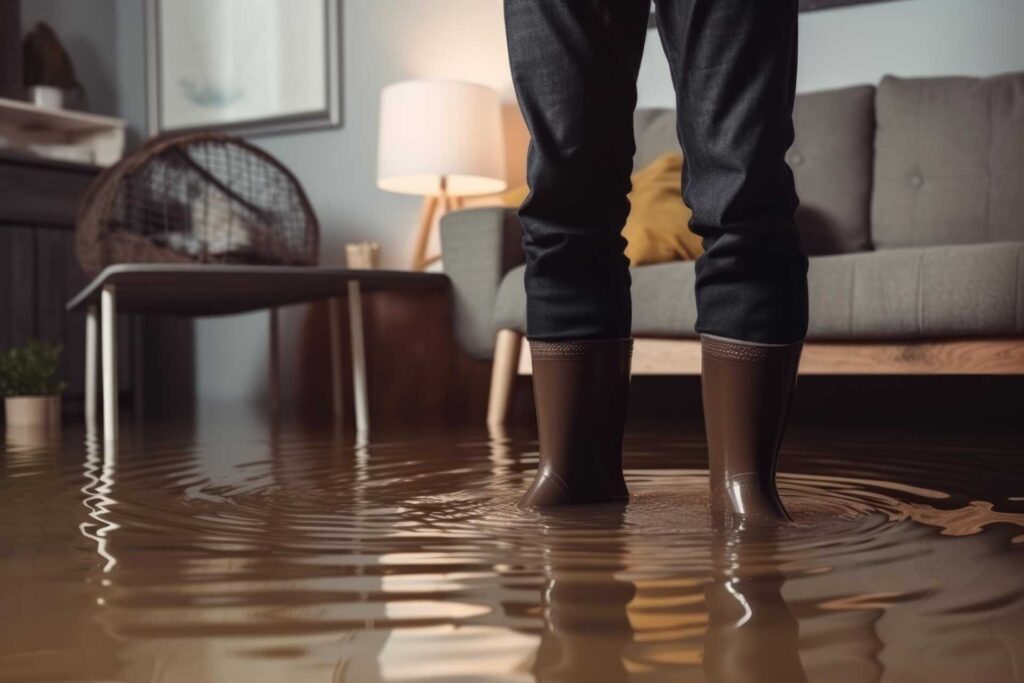
Contents
Many homeowners underestimate how quickly mold can develop after a spring flood. Without swift action, you risk structural damage and hazardous mold growth. Mold Prevention is key to safeguarding your home and ensuring a safe living environment. By following the right cleanup and moisture control strategies, you can stop mold before it spreads. Explore essential steps to protect your property and maintain a healthy space.
Key Takeaways
- Assess the extent of water damage and document findings with photos for insurance claims and future reference.
- Remove standing water promptly using a wet/dry vacuum and ensure proper ventilation to expedite drying.
- Use mold-resistant cleaning solutions on affected areas and regularly inspect for signs of mold growth.
- Employ dehumidifiers and maintain indoor humidity levels below 60% to prevent moisture accumulation.
- If damage is extensive or water is contaminated, seek professional assistance for thorough cleanup and safety.
Assessing the Damage After a Spring Flood
After a spring flood, evaluating the damage is essential to understanding the extent of the impact on your property and community. Start by conducting a thorough damage evaluation. Look for signs of water intrusion, structural instability, and affected personal belongings. Document everything with photos and notes; this will help you when filing a claim with your flood insurance provider.
Next, reach out to your insurance company promptly. They may require specific documentation to process your claim, and understanding your coverage is vital. Make sure you’re aware of what’s covered under your policy, as it can vary considerably.
Additionally, consider connecting with your neighbors. Sharing experiences can provide support and insight into recovery efforts. By evaluating the damage together, you foster a sense of community and resilience, which can be invaluable during this challenging time.
Your proactive approach not only aids in recovery but strengthens bonds with those around you.
Essential Tools and Supplies for Cleanup
Once you’ve assessed the damage and documented your findings, it’s time to gather the right tools and supplies for cleanup.
Having the essential cleaning supplies and safety gear at your disposal will make the process smoother and more efficient.
Here’s a list of must-have items to kickstart your cleanup:
- Heavy-duty trash bags for disposing of debris
- Rubber gloves to protect your hands from contaminants
- Mold-resistant cleaning solutions to prevent future growth
- A wet/dry vacuum for effective water removal
These tools help you tackle the immediate mess and ensure your safety while you work.
Remember, proper preparation is key to a successful recovery.
Steps for Effective Water Extraction
To effectively extract water after a flood, you first need to assess the extent of the damage.
This step allows you to prioritize areas and decide on the right equipment to use.
Once you’ve extracted the water, ensuring thorough drying is essential to prevent mold growth and further issues.
Assess the Water Damage Extent
How can you effectively assess the extent of water damage in your home? Begin by checking the water level in affected areas, as this helps you determine how far the water has spread.
Conduct a thorough damage assessment by examining walls, floors, and personal belongings. Look for signs like discoloration, warping, or soft spots that indicate hidden damage.
- Document everything with photos for insurance purposes.
- Identify which materials are salvageable versus those that need replacement.
- Pay attention to odors, as they can signal mold growth.
- Don’t forget to check your HVAC system for water exposure.
Taking these steps will guide you in understanding the severity of the damage and what actions to take next.
Use Proper Equipment
Effective water extraction requires using the right equipment to minimize damage and accelerate recovery. Start by investing in high-quality waterproof gear, like boots and gloves, to keep yourself dry and protected from contaminants.
Don’t overlook the importance of safety equipment, such as respirators and goggles, especially if you’re dealing with mold or hazardous materials. A powerful wet/dry vacuum is essential for removing standing water quickly, while submersible pumps can efficiently handle larger volumes.
Additionally, consider industrial fans and dehumidifiers to aid in drying out affected areas. Using the proper tools speeds up the process and ensures your safety and well-being.
When you’re well-equipped, you’re better prepared to tackle the challenges of flood recovery together.
Ensure Thorough Drying
Thorough drying is essential for preventing further damage and mold growth after water extraction.
You’ll want to employ effective drying techniques and utilize moisture detection tools to ensure every corner of your space is dry.
Here are some steps to follow:
- Use dehumidifiers to reduce humidity levels.
- Set up fans to increase air circulation and promote evaporation.
- Check for hidden moisture in walls and floors with moisture meters.
- Monitor drying progress regularly, adjusting your strategy as needed.
Drying Out Your Home Thoroughly
Although spring floods can cause extensive damage to your home, taking swift action to dry it out can greatly reduce long-term issues like mold and structural weakness.
Start by measuring moisture levels in affected areas with a moisture meter, which helps pinpoint problem spots. Once you identify high-moisture zones, employ effective drying techniques. Open windows and doors to increase airflow, and use fans and dehumidifiers to expedite the process.
If possible, remove soaked furniture and carpets, as these can trap moisture. Additionally, tear out any water-damaged drywall to prevent hidden mold growth.
Keep checking moisture levels daily to confirm everything is drying properly. Remember, the goal is to achieve a thoroughly dry environment, ideally below 60% humidity.
Mold Prevention Techniques Post-Cleanup
Once you’ve cleaned up after a flood, it’s vital to implement mold prevention techniques to safeguard your home.
You’ll want to focus on proper ventilation strategies, humidity control methods, and establishing a routine for regular inspections.
These steps will help you greatly reduce the risk of mold growth in the aftermath of your cleanup efforts.
Proper Ventilation Strategies
When you’ve completed cleanup after a spring flood, ensuring proper ventilation is essential to prevent mold growth.
Good air circulation helps dry out affected areas, reducing the risk of mold thriving in damp conditions.
Here are some effective strategies:
- Open windows to promote cross-ventilation, allowing fresh air to flow through your space.
- Use fans to enhance air circulation, directing airflow towards wet surfaces to speed up drying.
- Inspect ventilation systems to ensure they’re functioning properly and not recirculating stale air.
- Consider dehumidifiers in enclosed spaces to help maintain lower moisture levels.
Humidity Control Methods
To effectively prevent mold after a spring flood, controlling humidity levels in your home is vital. Implementing proper humidity control techniques and moisture management strategies can greatly reduce the risk of mold growth. Here are some effective methods you can adopt:
| Humidity Control Method | Description |
|---|---|
| Dehumidifiers | Use to remove excess moisture from the air. |
| Ventilation Systems | Ensure proper airflow to decrease humidity. |
| Regular Maintenance | Check for leaks and repair them promptly. |
Regular Inspections Routine
After addressing humidity control methods, establishing a regular inspection routine is vital for mold prevention in your home following a spring flood.
Regular inspections help you identify mold growth and keep your living environment safe and healthy. Consistently conducting these inspections is a key aspect of routine maintenance.
Here are some key points to reflect on:
- Check for water leaks around pipes and appliances.
- Inspect basements and crawl spaces for dampness.
- Look for signs of mold growth on walls, ceilings, and floors.
- Ensure proper ventilation in areas like bathrooms and kitchens.
When to Call Professional Restoration Services
Determining the right moment to call professional restoration services can considerably impact the outcome of your flood recovery efforts.
If you notice persistent signs of damage like discoloration on walls, a musty odor, or visible mold growth, it’s essential to act quickly. These indicators often signal underlying issues that you mightn’t be equipped to handle alone.
When to hire professionals depends on the severity of the damage and your comfort level with DIY repairs. If water has infiltrated your home’s structure or if you’re dealing with contaminated water, it’s best to seek expert help.
Professionals have specialized equipment and expertise to thoroughly assess and address the damage, ensuring your home is safe and healthy. Waiting too long could lead to more extensive repairs and health risks, so trust your instincts and don’t hesitate to reach out for assistance.
Summary
Spring flood recovery is essential to safeguarding your home and health. By taking proactive steps—like thorough cleanup and moisture control—you can greatly reduce the risk of mold growth. If the damage feels overwhelming, don’t hesitate to reach out to professional restoration services. Your swift action now can protect your home and loved ones from potential health risks in the future.
Recent Posts
7 Best Flood Cleanup and Restoration Solutions
Imagine standing in a room where the walls glisten with water, remnants of a flood
What Are Effective Flood Cleanup Solutions?
When faced with flood damage, your first step is to assess the situation carefully. You
Fast Water Damage Recovery: FAQs Answered
When you face water damage, knowing the right steps to take can make all the
